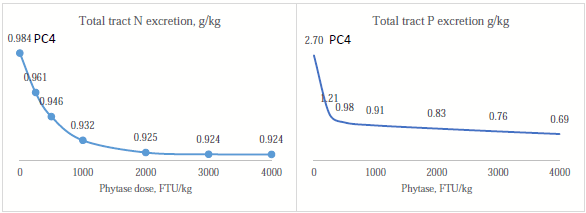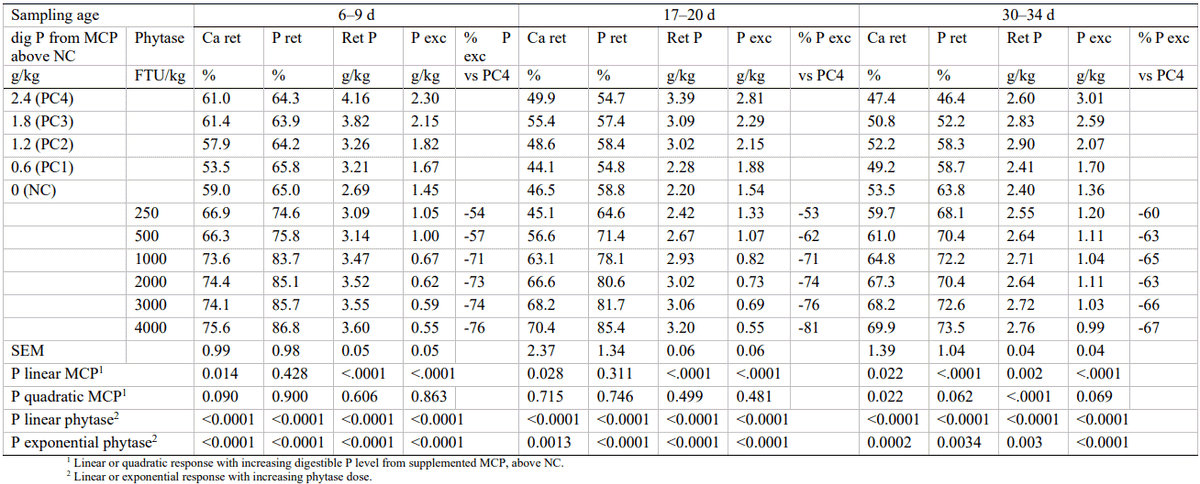I. INTRODUCTION
Phytase is commonly used in broiler diets at a typical dose level of 1000 FTU/kg feed to increase the P availability from phytate and reduce the need for inorganic phosphate inclusion. Increasing the phytase dose above this level is expected to further reduce the need to add inorganic phosphate and further reduce P excretion. In addition, if a phytase can break down phytate quickly and completely in the upper gastrointestinal tract, it will mitigate the anti-nutritional effect of phytate, resulting in improved amino acid (AA) digestibility and reduced N excretion. Recent studies have reported that a novel consensus bacterial 6-phytase variant (PhyG) at 1000, 2000 and 4000 FTU/kg feed can break down 88, 97 and 100% of inositol hexaphosphate (IP6), respectively, in a mixed grain diet containing 3 g/kg phytate-P (Dersjant-Li et al, 2022a) as well as improve P and AA digestibility with increasing phytase dose (Babatunde et al., 2021, 2022; Dersjant-Li et al., 2022b). This study evaluated the effect of increasing the dose of PhyG on P and N excretion and bone ash in broilers, compared to control diets with increasing level of digestible P from monocalcium phosphate (MCP).
II. METHOD
A basal diet (negative control, NC) was formulated based on wheat, corn and soybean meal (SBM), with inclusion of 5–7% rapeseed meal and 1.4–2.2% rice bran, meeting nutrient and energy requirements (CVB, 2019) except for P and calcium (Ca). The basal diet contained 1.2 g/kg MCP (providing 0.23g/kg digestible P) in starter (0–10 d) and was inorganic phosphate-free in grower (10–21 d) and finisher (21–35 d). The NC diets were supplemented with MCP to provide 0.6 g/kg (PC1), 1.2 g/kg (PC2), 1.8 g/kg (PC3) or 2.4 g/kg (PC4) digestible P from MCP; PC4 was considered a commercially relevant control diet containing 4.2, 3.9 and 3.8 g/kg digestible P in starter, grower and finisher phases, respectively. Levels of Ca were adjusted in the PC diets to maintain Ca:Ptotal between 1.23 and 1.3. The NC was supplemented with 250, 500, 1000, 2000, 3000 or 4000 FTU/kg feed of PhyG (Axtra® PHY GOLD, Danisco Animal Nutrition & Health, IFF). No additional digestible AA or energy matrix was applied in order to maintain a consistent feed composition of the major ingredients in all diets with the only variables being MCP and limestone content. A filler was used to maintain dietary composition at 100%. Ross 308 male broilers were used with 6 replications of 20 birds/pen at the trial start. Celite was used as a digestibility marker. Diets were fed as pelleted diets ad lib and water was freely available. The analysed phytate-P content across control diets was 3.3, 3.1 and 2.8g/kg in starter, grower and finisher diets respectively. Table 1 summarizes the formulated digestible P, analysed total P, Ca and crude protein in the 5 control diets, in each feeding phase. Total excreta samples were collected from 6– 9, 17–20 and 31–34 d of age for P and N excretion measurements. Pooled toe samples from 4 birds/pen at day 10, 21 and 35 were collected for ash analysis. Linear and quadratic, or exponential curve fitting was performed to model the effect of increasing MCP level and of increasing phytase dose on toe ash, Ca, P retention, P and N excretion, respectively.
Table 1 - Formulated (Form) digestible P, analysed (Ana) total P, Ca and crude protein (CP) in control diets (g/kg as fed).
III. RESULTS
Bone ash results are presented in Table 2. Increasing MCP inclusion linearly or quadratically increased toe ash percentage. Increasing phytase dose exponentially increased toe ash percentage at all three timepoints. At all three timepoints, toe ash in treatment PhyG2000 FTU/kg was maintained equivalent to PC4; at d 35, toe ash in treatment PhyG3000 FTU/kg feed was numerically improved vs. PC4.
The effect of MCP inclusion and phytase dose on P and Ca retention, retainable P and total tract P excretion is presented in Table 3. Increasing phytase dose improved P and Ca retention and reduced P excretion in each phase. However, the reduction in P excretion was greater in starter and grower than in finisher phase. Phytase at 1000 FTU/kg reduced P excretion by 71 (starter), 71 (grower) and 65% (finisher) compared to PC4. Increasing the phytase dose from 1000 FTU to 2000 or 3000 FTU/kg further reduced P excretion (by 11 and 16%, respectively, in grower phase). Similarly, the improvement in Ca retention with increasing phytase dose was greater in starter and grower than in finisher phase (Table 3). In all phases, increasing the digestible P-from-MCP content of the diet linearly increased retainable P and P excretion, whilst in finisher phase the response to P retention was quadratic.
Across all three timepoints, increasing the phytase dose decreased total tract N excretion (Figure 1 left) and exponentially decreased P excretion (Figure 1 right). At dose level of 1000 and 2000 FTU/kg feed the phytase reduced N excretion by 5.3 and 6.0%, and reduced P excretion by 66.4 and 69.3%, respectively, vs PC4.
Table 2 - Effect of increasing MCP concentration or phytase dose on toe ash (%).
Figure 1 - Effect of increasing phytase dose on total tract P and N excretion, data analysed across all three timepoints).
IV. DISCUSSION
The retainable P in PC4 was 4.2, 3.4 and 2.6 g/kg respectively in starter, grower, and finisher phase, representing, respectively, 64, 55 and 46% of P intake. This indicated that the starter diet met the expected target of 4.2 g/kg digestible P. However, in grower and finisher phase, the formulated P exceeded the requirement and led to greater P excretion, despite the lower analysed total P content of the diet. Clearly, for maximizing P release, the optimal phytase dose level should be linked to both the dietary P requirement and phytate substrate level of the diet. However, increasing the phytase dose up to 2000 FTU/kg can further reduce N excretion due to extra-phosphoric effects. Recent studies have reported that when PhyG is applied in a phased dosing strategy to plant-based diets containing sufficient phytate substrate, inorganic P can be totally removed from day 1; bone ash, BW and FCR were maintained comparable to a nutritionally adequate control diet and to breeder’s performance objectives (Bello et al., 2022; Dersjant-Li et al, 2022c; Marchal et al, 2021). In conclusion, these data indicate that by increasing the dose of a highly effective phytase, it is feasible to further replace inorganic P in the diet, further reduce P and N excretion and enhance sustainable chicken meat production.
Table 3 - MCP inclusion and phytase dose effect on P and Ca retention (Ret, %), retainable P (Ret P, g/kg) and total tract P excretion (exc, g/kg).
Presented at the 34th Annual Australian Poultry Science Symposium 2023. For information on the next edition, click here. 

















